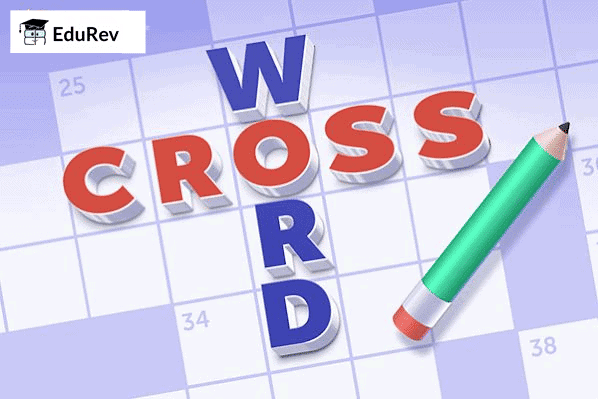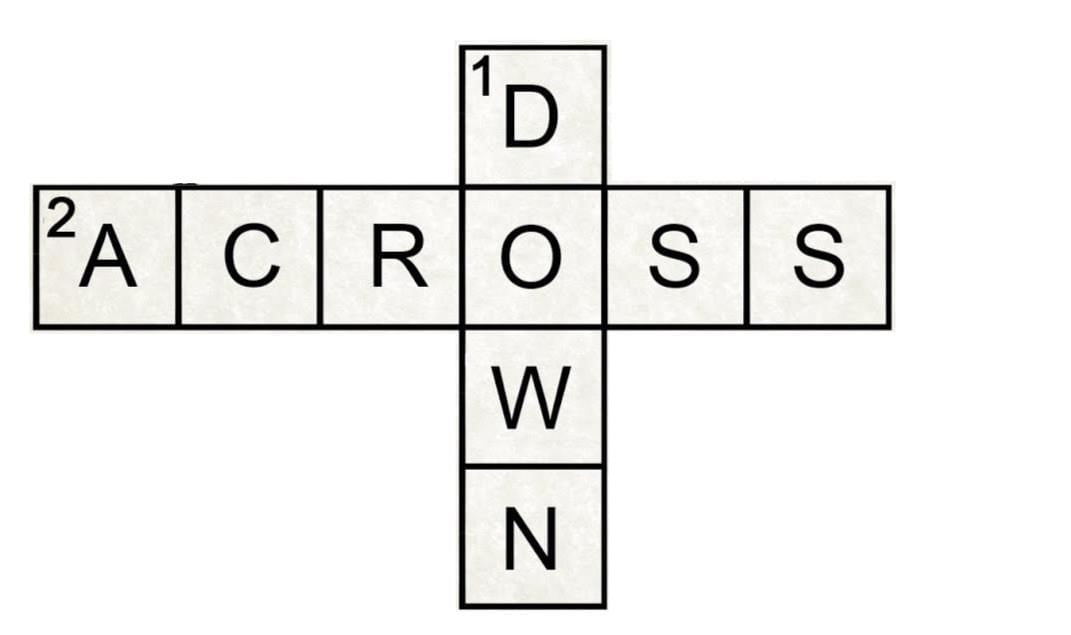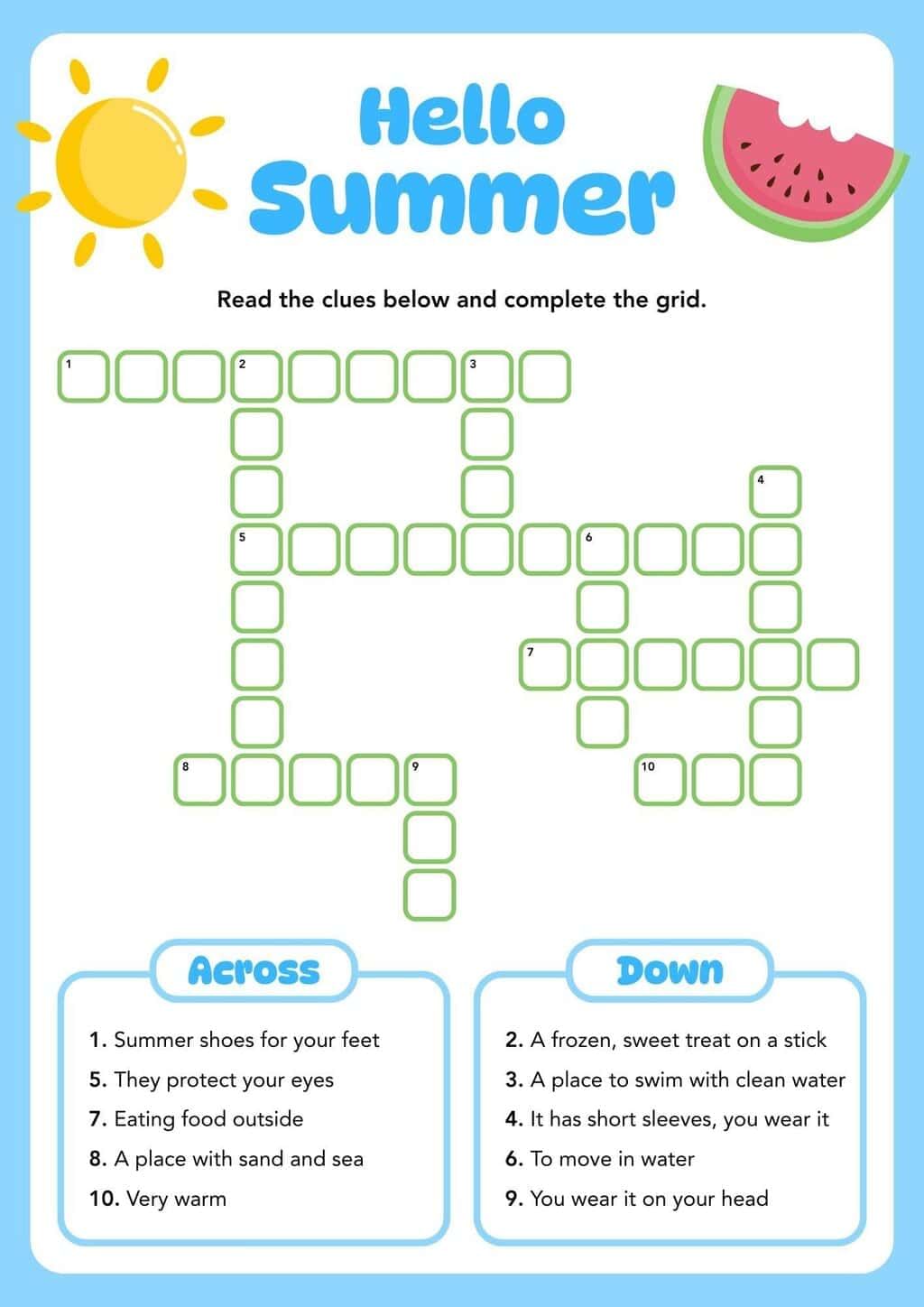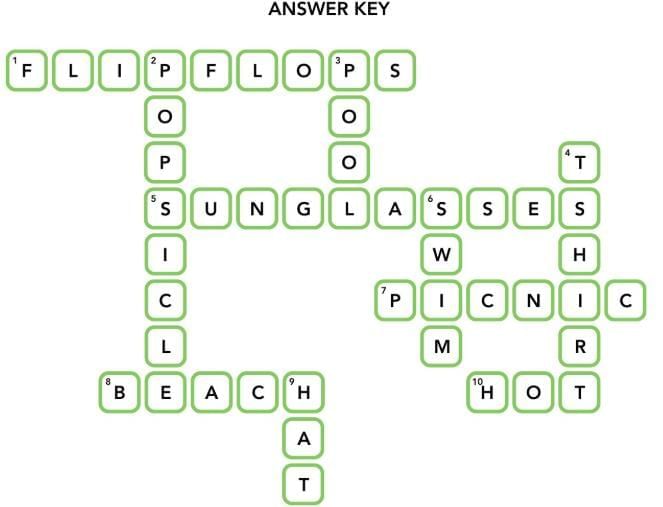What is Crossword? | Crossword Puzzles: Solve like a Pro - Class 1 PDF Download
What is a crossword?
A crossword is a word puzzle made on a rectangular grid of boxes arranged in rows and columns. Words are placed in the grid in two directions across (left → right) and down (top → bottom). Each word in the puzzle is linked to a short clue; the solver reads the clue and fills the correct word into the corresponding boxes.
Many words cross each other so a single letter can belong to both an across answer and a down answer. This intersection of words is what makes the puzzle solvable: letters filled from one clue help confirm or reveal letters for other clues.

Main parts and terms
- Grid: the pattern of boxes where letters go. The layout determines where words start and stop.
- Entry: any word placed in the grid (an across entry or a down entry).
- Clue: a short question, hint or prompt that leads to a word answer.
- Numbering: each entry has a number used to match the clue with its place in the grid.
- Length (enumeration): the number of letters in an answer; clues often show this to help solvers (for example: (3) means a three-letter answer).
- Crossing: where two entries share the same letter; crossing letters give checks that make solving easier.

How a crossword works — the basic idea
- Each clue corresponds to a specific entry in the grid.
- You read the clue, think of a word that fits the meaning, and check whether that word fits the number of boxes shown.
- If letters from crossing entries are already placed, those letters must match your guess. If they don’t match, the guess is probably wrong.
- As more entries are placed, the remaining unknown entries become easier because of the extra letters provided by crossings.
Types of clues (simple to advanced)
- Direct definition: a straightforward description (e.g., “A small dog (3)” → PUP).
- Fill-in-the-blank: sentence with missing word (e.g., “Twinkle, twinkle, little ___” → STAR).
- Synonym/Antonym clues: asks for a word with similar or opposite meaning.
- Category / general-knowledge clues: ask for names, places, dates, or facts (e.g., “Capital of France (5)” → PARIS).
- Picture clues: a picture stands for the answer (useful for young learners).
- Wordplay (intermediate/advanced): clues that use anagrams, hidden words, reversals, charades (concatenation of parts), or puns.
- Abbreviations and shorthand: clues that expect a shortened form (e.g., “Doctor (abbr.)” → DR).
- Cryptic clues (advanced): two-part clue where one part gives a straight definition and the other gives wordplay leading to the same word.
Solving strategies (how to approach a puzzle)
- Read all clues and fill in any you immediately know.
- Start with shorter words — they are easier and provide letters for crossing entries.
- Use crossing letters to narrow down choices for longer, trickier clues.
- Pay attention to what part of speech the clue suggests (noun, verb, adjective). The answer must match.
- Watch for indicator words that suggest tense, plurals, or abbreviations.
- If stuck, skip and return later — a letter from another solved clue might unlock it.
- For group work, discuss possible answers aloud; collaboration can reveal the right word sooner.
Classroom uses and learning benefits
- Vocabulary building: introduces and reinforces words in context.
- Spelling practice: students must spell words correctly to fit.
- Reading comprehension: students learn to read clues carefully and extract meaning.
- Logical thinking: crossing letters create constraints that require reasoning.
- Subject integration: clues can be drawn from science, math, social studies and literature.
- Creativity and ownership: students can create their own crosswords, writing clues and answers.
Examples of clues with short explanations
(Simple examples)
- Clue: “A flying animal (3)”
Answer: BAT. (Direct definition) - Clue: “____ and go (two-word phrase)”
Answer: STOP (as in “stop and go” — fill-in-the-blank). - Clue: “Things you write on (plural, 4)”
Answer: PENS. (Category + plural)
(Intermediate examples)
- Clue: “Not heavy (4)” → Answer: LIGHT. (Antonym / direct)
- Clue: “Anagram of ‘LEAP’ (4)” → Answer: PALE. (Anagram indicator — rearrange letters)
- Clue: “Rhymes with ‘night’ (4)” → Answer: LIGHT. (Phonetic/homophone hint)
(Advanced example — explanation)
- Clue: “Small insect often in gardens (5)” → Answer: ANT would be 3 letters; if grid shows (5) check for plural or compound like ANTLY — here the enumeration forces correct form; always ensure the clue’s word length matches the intended answer.
- (This illustrates the importance of accurate enumeration.)
Practice Crossword

Ans:

Tips for assessment
- Use crosswords as short formative checks — they reveal who knows vocabulary and who needs more practice.
- Provide answer keys for self-checking or peer review.
- Encourage students to explain why a clue leads to an answer — this deepens understanding.
- Ask students to create clues for a given list of vocabulary words as a follow-up task.
A crossword is a flexible classroom tool: it can be simple and picture-based for beginners, or richly wordy and puzzle-like for older students. The core idea is always the same — clues lead to words that cross and check each other, turning language learning into an engaging, problem-solving activity.
|
1 videos|54 docs
|
FAQs on What is Crossword? - Crossword Puzzles: Solve like a Pro - Class 1
| 1. What are the main parts of a crossword puzzle? |  |
| 2. How do clues work in a crossword puzzle? |  |
| 3. What are some common types of clues found in crossword puzzles? |  |
| 4. What are effective strategies for solving crossword puzzles? |  |
| 5. How can crossword puzzles be used in the classroom? |  |
















